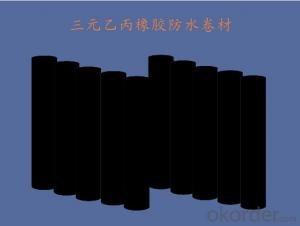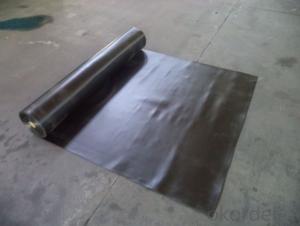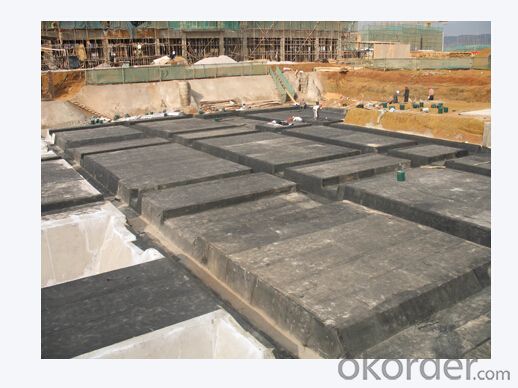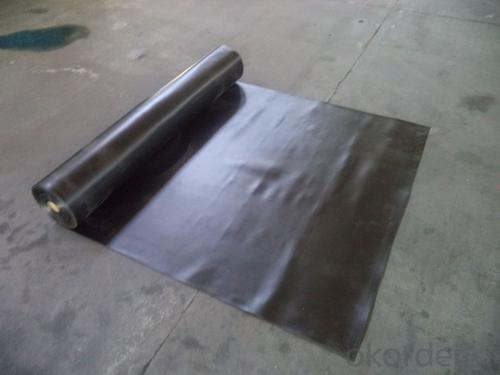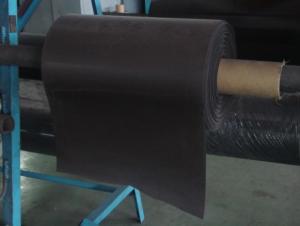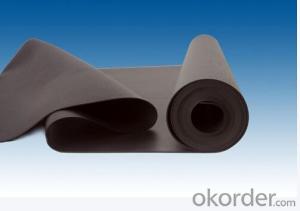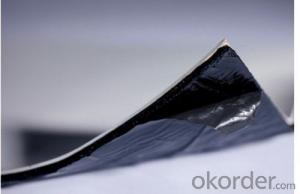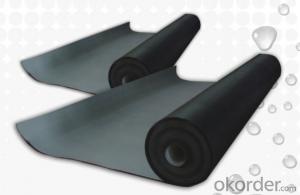Roof EPDM Waterproofing Membrane
- Loading Port:
- China Main Port
- Payment Terms:
- TT OR LC
- Min Order Qty:
- -
- Supply Capability:
- -
OKorder Service Pledge
OKorder Financial Service
You Might Also Like
EPDM waterproofing membrane
1. Brief Introduction:
It is a kind of self-adhesive waterproof coiled material based on polymer rubber and superior asphalt, together with polyethylene film and aluminum foil as surface material or no film(Double-sided self-adhesive). And it adopts the package preventing-adhesion-isolation-layer package, and dividing into no fiber and polyester fiber two parts.The coiled material has perfect performances, simple operation, non-pollution and etc.
2. Characters:
1)Good flexibility, creep properties and malleability, and the superior adapting ability to the deformation of the primary stress generated.
2). Tight adhesion between waterproof layer and basic layer, no channeling water. Having self healing ability after piercing.
3).Operation without heating. And possessing the reliability of pasting by itself with super strong connection of sheet materialand adhesion of same base.
4). Convenient and safe operation, no pollution to the environment.
3. Application:
Widely applied in roofing, basement, tunnel, railway and subway and waterproofing projects. And also used for other waterproof projects as wooden and metal structural surface.
4. Package and Storage:
Each Roll with one plastic bag with or without pallets.
Keep in dry and ventilated place. Avoid shining and raining. Height of stack not more than 5 layers. Shelf life:12 months.
5. Specification:
Type | EPDM Waterproof Rubber Membrane | |||
Material | EPDM Rubber | |||
Thickness | 1.0mm | 1.2mm | 1.5mm | 2.0mm |
Size | 1.2m(width) * 20m(length)/roll | |||
Type | Vulcanized | |||
Pattern | Non-reinforced(homogeneous) | |||
Packing | 24sqm--80sqm/roll, with plastic bag | |||
Color | Black | |||
Application | Roofs, basement, pond, Lake, steel structure roof, swimming pool, underground, tunnel, etc | |||
5. Some photos:
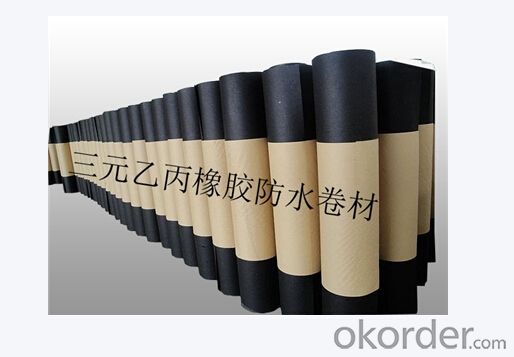
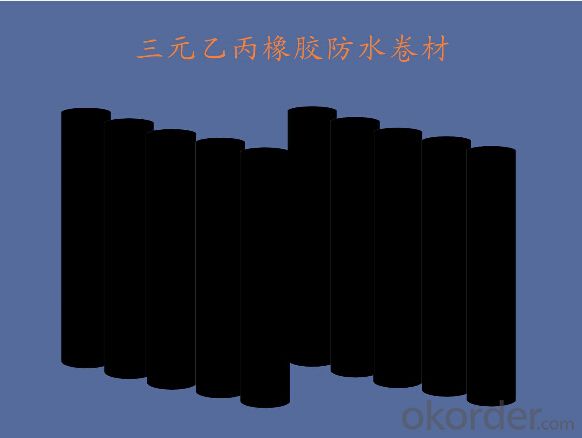
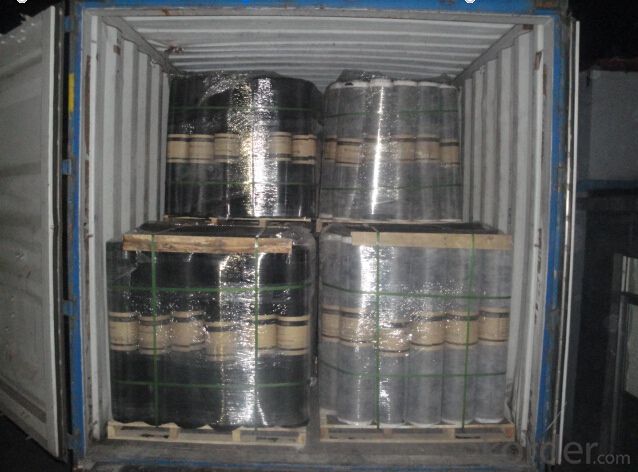
- Q: Are there any specific considerations for installing a waterproofing membrane on metal surfaces?
- Yes, there are specific considerations for installing a waterproofing membrane on metal surfaces. When installing a waterproofing membrane on metal surfaces, it is important to consider the compatibility of the membrane with the specific type of metal being used. Some waterproofing membranes may not adhere well to certain types of metal surfaces, so it is necessary to choose a membrane that is specifically designed for use on metal. Additionally, it is important to ensure that the metal surface is properly prepared before installing the waterproofing membrane. This may involve cleaning the surface thoroughly to remove any dirt, grease, or other contaminants that could interfere with the adhesion of the membrane. It may also be necessary to prime the metal surface to improve adhesion. Another consideration is the expansion and contraction of the metal surface due to temperature changes. Metal surfaces can expand and contract significantly with temperature variations, and this movement can potentially affect the performance of the waterproofing membrane. Therefore, it is important to choose a membrane that can accommodate the movement of the metal without compromising its waterproofing capabilities. Furthermore, it is essential to consider the type of waterproofing membrane being used. There are different types of membranes available, including liquid-applied membranes, sheet membranes, and peel-and-stick membranes. Each type of membrane has its own installation requirements, so it is crucial to follow the manufacturer's guidelines to ensure proper installation on metal surfaces. Lastly, it is important to consider any additional factors that may affect the performance of the waterproofing membrane on metal surfaces. These factors can include exposure to UV radiation, potential for corrosion, and compatibility with other building materials or systems. Taking these considerations into account will help ensure a successful and long-lasting installation of a waterproofing membrane on metal surfaces.
- Q: Can a waterproofing membrane be used in earthquake-prone areas?
- Yes, a waterproofing membrane can be used in earthquake-prone areas. In fact, it is highly recommended to use a waterproofing membrane in such areas to protect buildings and structures from potential water damage caused by earthquakes. Waterproofing membranes are designed to create a barrier against water infiltration, which can be crucial in preventing structural damage and maintaining the integrity of a building during seismic events. Additionally, these membranes can also provide some level of flexibility and elasticity, which can help absorb and distribute the forces exerted during an earthquake, reducing the risk of cracks and leaks. However, it is important to ensure that the waterproofing membrane used is specifically designed and tested to meet the requirements of earthquake-prone areas, considering factors such as the intensity and frequency of seismic activity in the region. Consulting with a structural engineer or a waterproofing specialist is highly recommended to determine the most suitable waterproofing system for earthquake-prone areas.
- Q: Can a waterproofing membrane be used on brick walls?
- Yes, a waterproofing membrane can be used on brick walls. Brick is a porous material that can absorb water and moisture, making it susceptible to damage and deterioration over time. Applying a waterproofing membrane on brick walls helps to prevent water penetration and protect the structural integrity of the bricks. The membrane acts as a barrier, preventing water from seeping into the bricks while still allowing moisture to evaporate. This helps to keep the bricks dry and reduces the risk of water-related issues such as efflorescence, mold, and mildew. Additionally, a waterproofing membrane can also enhance the thermal insulation properties of the brick walls by reducing heat loss and improving energy efficiency. It is important to choose a waterproofing membrane specifically designed for use on masonry surfaces to ensure proper adhesion and long-lasting protection.
- Q: Can waterproofing membranes be used in basements?
- Yes, waterproofing membranes can be used in basements. Waterproofing membranes are commonly used in basements to prevent water intrusion and dampness. By applying these membranes on the walls and floors of the basement, they create a barrier that prevents moisture from seeping into the basement, helping to keep the space dry and protected from water damage.
- Q: Can waterproofing membranes be used on rooftop terraces?
- Indeed, rooftop terraces can utilize waterproofing membranes. In fact, they are frequently employed to safeguard the terrace's structural integrity and prevent water damage to the underlying structure. Rooftop terraces are exposed to diverse weather conditions, encompassing rain, snow, and UV rays, which can result in leaks and deterioration. Waterproofing membranes function as a barrier, impeding water from permeating the surface and causing harm. These membranes are specifically engineered for outdoor usage and can endure the harsh conditions commonly encountered on rooftops. They are obtainable in various materials, such as modified bitumen, EPDM (ethylene propylene diene terpolymer), and PVC (polyvinyl chloride), allowing for flexibility in selecting the most suitable option for a specific terrace. Moreover, waterproofing membranes can be installed beneath a variety of terrace finishes, including pavers, tiles, and decking, offering a versatile solution for diverse design preferences. Overall, it is highly advisable to employ waterproofing membranes for rooftop terraces to ensure their longevity, durability, and resistance to water-related problems.
- Q: Can waterproofing membranes be used on concrete planters?
- Yes, waterproofing membranes can be used on concrete planters. Waterproofing membranes are designed to create a barrier against water, preventing it from seeping through the concrete and causing damage. By applying a waterproofing membrane to the concrete planter, you can ensure that the planter remains watertight, preventing water from leaking out and potentially damaging the surrounding area. This can be especially beneficial for planters located indoors or in areas where water leakage could cause structural damage or create a mess. Additionally, waterproofing membranes can also help protect the concrete from freeze-thaw cycles, which can cause cracking and deterioration over time. Overall, by using waterproofing membranes on concrete planters, you can extend their lifespan and maintain their functionality for a longer period of time.
- Q: What is BSB waterproofing membrane
- SBS waterproofing membrane is: The thermoplastic elastomer is used as a modifier to make impregnated and coated materials, and the upper surface is covered with a polyethylene film, fine sand, mineral sheet (granule) or aluminum foil, copper foil and other insulating material made of curled sheet waterproof materials. Styrene-Butadiene-Styrene means: styrene-butadiene-styrene. SBS rubber modified petroleum asphalt for the invasion of the cover layer to polyester fiber non-woven fabrics, jute cloth, fiberglass mats were made for the fetal base, the plastic film for the anti-sticking isolation layer, the selection, ingredients, eutectic , Invasion, composite molding, curling and other processes processing production.
- Q: Does a waterproofing membrane require any special precautions during installation?
- Yes, a waterproofing membrane does require special precautions during installation. It is important to ensure that the surface to be waterproofed is clean, dry, and free from any contaminants or loose materials. The membrane should be installed in accordance with the manufacturer's instructions, paying attention to proper overlap and seam sealing. It is also crucial to inspect the membrane for any damage or defects prior to installation. Additionally, proper safety measures should be taken, such as wearing protective clothing and using appropriate tools and equipment.
- Q: Can a waterproofing membrane be used for residential swimming pools?
- Indeed, residential swimming pools can benefit from the use of a waterproofing membrane. These membranes are frequently employed in construction to safeguard against water infiltration and can be utilized on diverse surfaces including concrete, tile, and metal. By forming a barrier, they effectively prevent water from permeating the pool structure, thereby preserving its integrity and averting leaks. Furthermore, waterproofing membranes afford protection against other types of harm such as corrosion and deterioration resulting from chemicals or adverse weather conditions. Consequently, it is crucial to choose a top-notch waterproofing membrane specifically designed for swimming pool applications in order to guarantee long-lasting safeguarding and durability.
- Q: Can a waterproofing membrane be used for plant rooms or mechanical spaces?
- Plant rooms or mechanical spaces can benefit from the use of a waterproofing membrane. These areas house various equipment, machinery, and systems, often containing pipes, tanks, and other components that require protection from water damage. A waterproofing membrane serves as a strong and flexible barrier that effectively prevents water infiltration. It can be applied to walls, floors, or ceilings, ensuring the longevity and functionality of the equipment and systems by safeguarding them against water leaks or moisture damage. Furthermore, the application of a waterproofing membrane also serves as a vapor barrier, preventing the accumulation of condensation or humidity that can adversely affect sensitive equipment.
Send your message to us
Roof EPDM Waterproofing Membrane
- Loading Port:
- China Main Port
- Payment Terms:
- TT OR LC
- Min Order Qty:
- -
- Supply Capability:
- -
OKorder Service Pledge
OKorder Financial Service
Similar products
Hot products
Hot Searches
Related keywords
